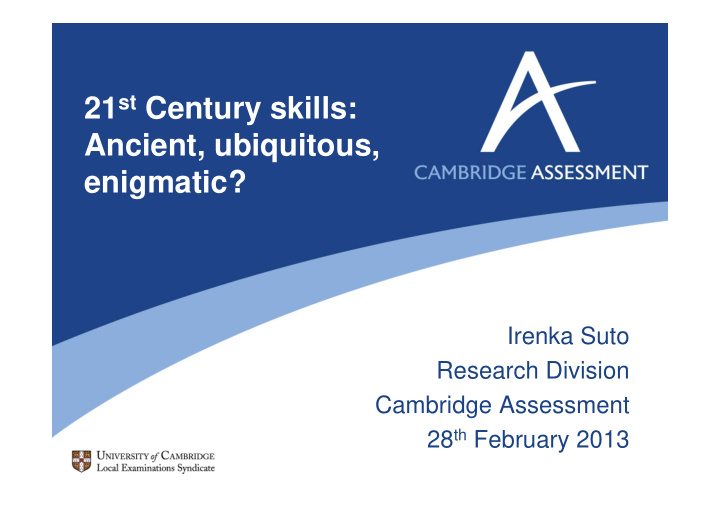



21 st Century skills: Ancient, ubiquitous, enigmatic? Irenka Suto Research Division Cambridge Assessment 28 th February 2013
An introduction to 21 st Century skills • What is meant by this term? • How are 21 st Century skills developed in young people?
The broad argument for 21 st Century skills • Life in a global economy is highly international, multicultural, and inter-connected • Seismic advances in ICT & in access to it • Economies of developed countries have shifted from a basis of material goods & services to information & knowledge • The understanding and skills needed today are different • Emphasis on use of information over possession of facts and figures
What are 21 st Century skills? • No single widely-accepted definition • Literature contains hundreds of overlapping descriptors of the skills set:
ATC21S categories of 21 st Century skills Category Skills Ways of 1. Creativity & innovation thinking 2. Critical thinking, problem-solving, decision-making 3. Learning to learn, metacognition Ways of 4. Communication working 5. Collaboration (teamwork) Tools for 6. Information literacy working 7. ICT literacy Living in the 8. Citizenship – local & global world 9. Life & career 10. Personal & social responsibility
Other perspectives Cambridge University Multilingualism : admissions: • Speaking English in addition Mental fluency , articulacy , to a different native language high motivation , and an • Speaking another language interest in complexity (not necessarily English) Links to ‘ emotional Subject-specific uses : 21 st Century literacy intelligence ’, a (malleable) aspect of personality 21 st Century science etc. ( Subjects must evolve to meet new needs)
There are multiple approaches to developing 21 st Century skills in young people.
Approach 1: Continue with long-standing teaching methods • Nothing new - current focus is due to deficits in aspects of current education system • Creative, critical & analytical thinking valued by many philosophers & educators (Socrates to John Dewey) • Maths, science, & vocational courses can be reconceptualised in terms of problem-solving & critical thinking skills (e.g. ACME, 2011; Rose, 2011)
Bloom et al.’s taxonomy of educational objectives (cognitive domain, 1956) Analyze Evaluate Create Creativity & innovation Critical Information thinking, p-s literacy & d-m Apply Life & career Learning to learn, Outside Bloom’s metacog. cognitive domain Citizenship Understand Communication Personal & social responsibility Collaboration Remember ICT literacy
Approach 2: Develop curricula covering 21 st Century skills explicitly • Critical thinking now a subject in its own right • Thinking skills and global perspectives courses • Debate over positioning of ICT in the curriculum:
Approach 3: Adopt a skills-centred pedagogy in schools and colleges E.g. RSA’s Opening Minds framework: 5 competences: Teachers use the competences to develop curricula to suit their own schools, and can use whatever content they like
Approach 4: Nurture 21 st C skills through extra- I curricular activities • Concerns over inequality and inequity
Approach 5: Develop 21 st C skills in the workplace “Workplace apprenticeship is the fundamental principle of vocational training in Germany and is thought to combine the most favourable conditions for developing skills.” Tremblay and Le Bot (2003, p. 14)
Approach 6: Cultivate 21 st C skills through independent research projects
Recommend
More recommend